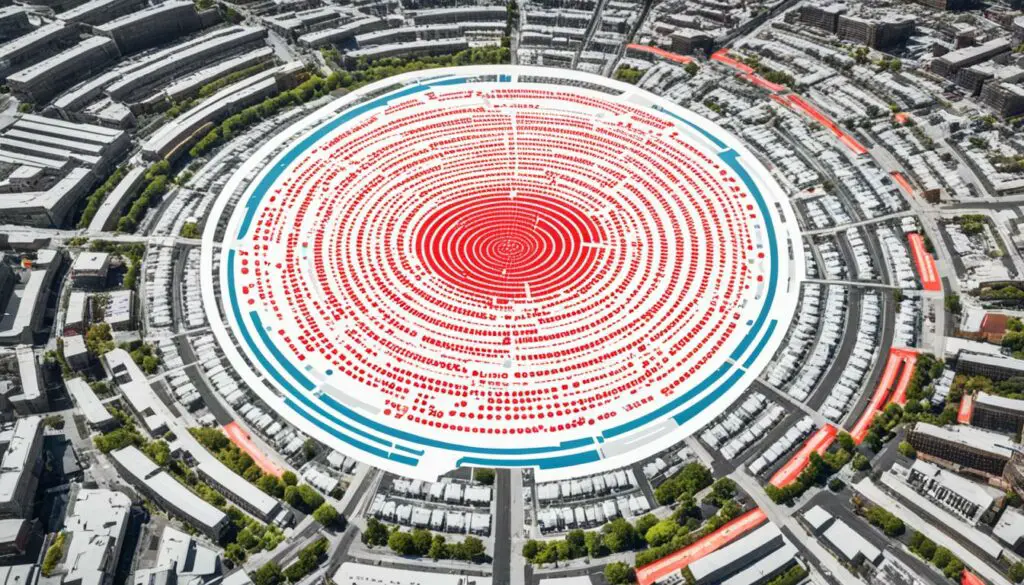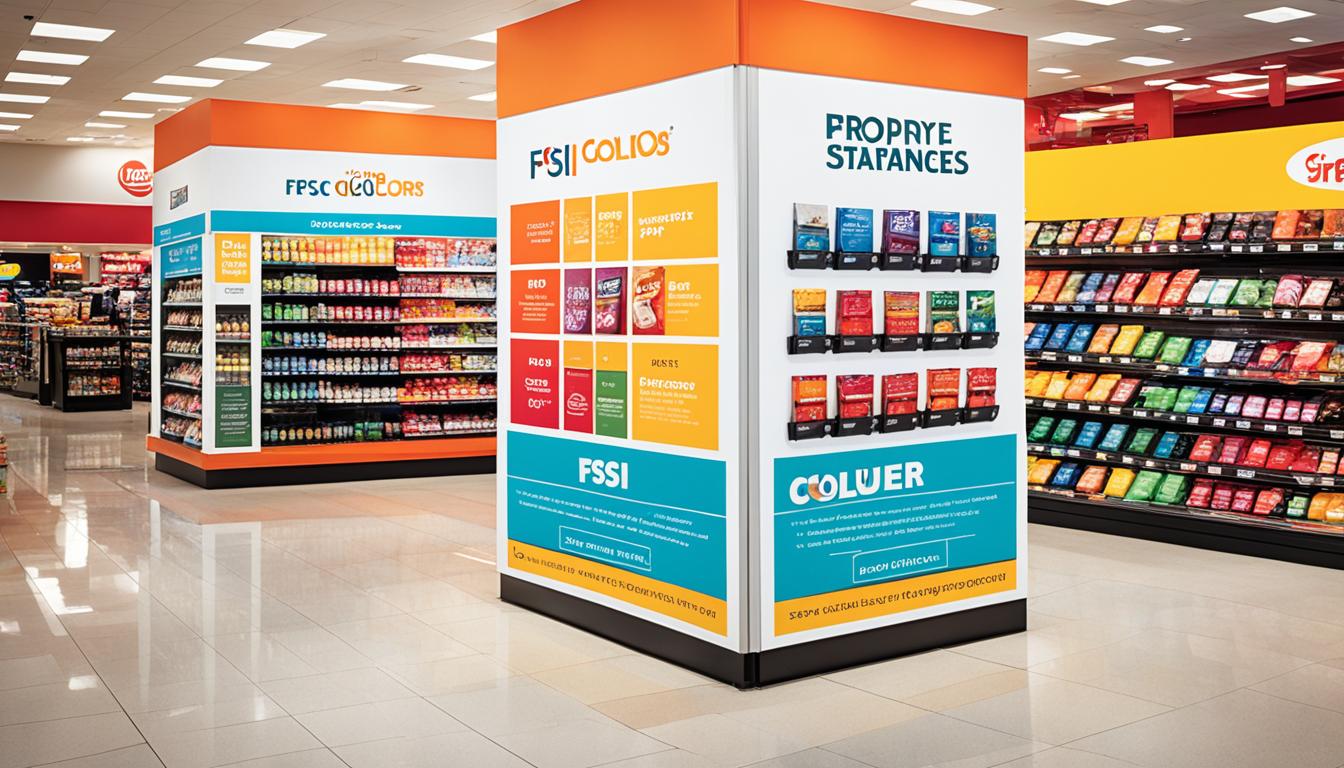Marketing strategies play a crucial role in the success of grocery stores. In 2024, with the ever-evolving retail landscape, it is important for grocery stores to adopt effective marketing tactics to drive customer engagement and boost sales. One such strategy is the utilization of location-based marketing.
Location marketing is a powerful strategy that grocery stores can utilize to boost sales and engage customers. It relies on collecting data from mobile phone sensors and Wi-Fi signals to deliver personalized messaging to customers based on their location. By leveraging location-based marketing tactics, grocery stores can create a more meaningful and relevant shopping experience for their customers.
Key Takeaways:
- Location marketing is a powerful strategy for grocery stores to boost sales and engage customers.
- Collecting data from mobile phone sensors and Wi-Fi signals enables grocery stores to deliver personalized messaging based on customer location.
- Geotargeting, geofencing, proximity marketing, and location-based mobile apps are effective tactics for grocery stores.
- Geotargeting delivers ads to nearby consumers, increasing brand awareness and driving foot traffic.
- Geofencing creates virtual boundaries for targeted messaging, enhancing customer engagement and encouraging repeat visits.
Geotargeting: Delivering Ads to Nearby Consumers
Geotargeting is a powerful location marketing tactic that allows grocery stores to deliver targeted ads or promotions to consumers who are in the vicinity of the store. By specifically tailoring their messaging to customers in the area, grocery stores can increase brand awareness, drive foot traffic, and ultimately boost sales. This strategy can be implemented through various omni-channels such as search engines, social media platforms, or mobile apps, ensuring maximum reach and engagement.
One effective way to use geotargeting is by delivering targeted ads to customers who search for “grocery stores near me” on search engines. By displaying ads or promotions during these search queries, grocery stores can capture the attention of potential customers who are actively seeking nearby options. This not only increases the store’s visibility but also provides an opportunity for immediate conversions as customers are already in a shopping mindset.
Furthermore, geotargeting on social media platforms allows grocery stores to reach customers who are in close proximity to their location. By leveraging the social media platforms’ advanced targeting capabilities, stores can ensure that their ads are seen by people who are more likely to visit their store. This targeted approach not only improves the effectiveness of ad campaigns but also helps to minimize wasted advertising budgets by reaching the right audience.
Here is an example of how geotargeting can be used effectively by a grocery store:
| Scenario | Implementation |
|---|---|
| A customer is approaching a grocery store | The grocery store’s mobile app detects the customer’s location and sends a push notification about ongoing promotions and discounts. |
| The customer searches for nearby grocery stores | The grocery store displays targeted ads on search engine results pages (SERPs) to capture the customer’s attention and encourage store visits. |
| The customer is browsing social media | The grocery store’s ad appears on the customer’s social media feed, showcasing personalized offers based on their current proximity to the store. |
By utilizing geotargeting, grocery stores can not only increase their visibility but also deliver personalized messaging that resonates with nearby consumers. This level of customization and relevance helps to establish stronger connections with potential customers and significantly enhances the likelihood of driving conversions.
Geofencing: Creating a Virtual Boundary for Targeted Messaging
Geofencing is a powerful location marketing strategy that grocery stores can use to engage customers and deliver personalized messaging. By creating a virtual boundary around the store, grocery stores can send push notifications or messages to consumers when they enter or exit the area. This allows for targeted and relevant messaging based on the customer’s location.
For example, when customers leave the store, they can receive a message with a coupon for their next purchase, encouraging them to return. Geofencing helps enhance customer engagement by providing timely and contextual messages that are tailored to their specific location.
Implementing geofencing technology enables grocery stores to stay connected with their customers even after they have left the store. By leveraging this strategy, stores can deliver personalized offers, promotions, and product recommendations based on the customer’s proximity to the store or specific product sections.
Geofencing also provides an opportunity for grocery stores to gather valuable data on customer behavior. By analyzing the response to geofenced messages, stores can gain insights into customer preferences, shopping patterns, and the effectiveness of their marketing campaigns.
Overall, geofencing is a valuable tool for grocery stores to enhance customer engagement, drive repeat visits, and boost sales. By leveraging the virtual boundary created through geofencing, stores can deliver personalized messaging that resonates with customers and creates a more seamless and relevant shopping experience.
Benefits of Geofencing:
- Delivers personalized messaging based on customer location
- Increases customer engagement and encourages repeat visits
- Provides an opportunity for targeted promotions and offers
- Allows for data collection and insights into customer behavior
| Geofencing | Benefits |
|---|---|
| Delivers personalized messaging based on customer location | Increases engagement and encourages repeat visits |
| Enables targeted promotions and offers | Provides data on customer behavior and preferences |
By implementing geofencing as part of their location marketing strategy, grocery stores can create a more targeted and personalized shopping experience for their customers. With the ability to send relevant messages and offers based on the customer’s location, geofencing enhances customer engagement and drives repeat business.
Proximity Marketing: Targeting Customers in Close Proximity
Proximity marketing is a powerful tactic that grocery stores can employ to engage customers and drive sales. This strategy involves sending personalized messages or promotions to customers when they are in close proximity to the store or specific products. By leveraging the power of proximity marketing, grocery stores can deliver timely and targeted promotions that incentivize customers to make purchases.
One effective application of proximity marketing is triggering messages when customers are standing in front of a particular product. For instance, if a customer is browsing the cereal aisle, they can receive a message on their mobile device about a promotional offer for a specific brand of cereal. This personalized recommendation not only provides relevant information to the customer but also increases the likelihood of them making a purchase. By delivering tailored messaging in real-time, grocery stores can enhance customer engagement and drive sales.
Proximity marketing can be implemented through various channels such as mobile apps, Bluetooth beacons, or location-based technologies. By utilizing these tools, grocery stores can track the location of customers within the store or its immediate vicinity and deliver targeted promotions accordingly. This level of personalization creates a unique shopping experience that resonates with customers and fosters brand loyalty.
Furthermore, proximity marketing enables grocery stores to optimize their promotional efforts by reaching customers when they are most likely to make a purchase. By targeting customers in close proximity to the store, grocery stores can capitalize on the immediate needs and desires of customers, increasing the chances of converting them into buyers. This targeted approach not only maximizes the effectiveness of marketing campaigns but also enhances the return on investment for grocery stores.
Overall, proximity marketing is a valuable strategy that grocery stores can leverage to engage customers, boost sales, and drive brand loyalty. By delivering personalized recommendations and promotions based on location, grocery stores can provide customers with a tailored shopping experience that meets their specific needs and preferences. Implementing proximity marketing can be a game-changer for grocery stores looking to stay ahead in the competitive retail landscape.
Benefits of Proximity Marketing:
- Increased customer engagement by delivering timely and targeted promotions
- Enhanced brand loyalty through personalized recommendations
- Optimized promotional efforts by reaching customers at the right time and place
- Improved return on investment for marketing campaigns
| Proximity Marketing Strategies | Benefits |
|---|---|
| Triggering messages when customers are near specific products | Increases the likelihood of purchase |
| Utilizing mobile apps or location-based technologies | Creates a unique shopping experience |
| Targeting customers in close proximity to the store | Maximizes the effectiveness of marketing campaigns |
Location-Based Mobile Apps: Providing Personalized Recommendations
One of the most effective location marketing strategies for grocery stores in 2024 is the development of location-based mobile apps. These apps utilize a customer’s location to provide personalized recommendations and promotions based on their proximity to specific products or stores. By leveraging the power of mobile technology, grocery stores can enhance the shopping experience for their customers and drive sales.
When a customer is near the store, the location-based mobile app can send a notification about in-store promotions or personalized recommendations based on the customer’s browsing history. For example, if a customer frequently purchases organic produce, the app can recommend new organic products or notify them of a special offer on their favorite brands.
This personalized approach not only increases customer engagement but also creates a sense of relevance and value. When customers receive targeted recommendations based on their location and preferences, they are more likely to view the suggestions as helpful and make a purchase. By tailoring the shopping experience to individual needs and preferences, grocery stores can foster customer loyalty and increase sales.
Moreover, location-based mobile apps can also be used to provide real-time information about product availability, store layouts, and in-store events. This gives customers the convenience of easily navigating the store and finding the products they need, ultimately leading to a more seamless and enjoyable shopping experience.
Table:
| Benefits of Location-Based Mobile Apps for Grocery Stores |
|---|
| 1. Personalized recommendations based on browsing history and location |
| 2. Increased customer engagement and loyalty |
| 3. Real-time information about product availability, store layouts, and in-store events |
| 4. Enhanced shopping experience and convenience |
By leveraging location-based mobile apps, grocery stores can provide personalized recommendations and promotions to their customers, increasing engagement, loyalty, and sales. The combination of tailored suggestions and convenient features creates a seamless shopping experience that meets the unique needs of each customer.
Location-Based Social Media Marketing: Targeting Past and Current Visitors
Location-based social media marketing is a highly effective strategy for grocery stores to engage past and current customers. By targeting these individuals with ads or promotions on social media platforms, grocery stores can increase customer engagement, foster brand loyalty, and drive sales.
For example, let’s say a customer has previously shopped at a grocery store and is currently in close proximity to the store. The store can leverage location-based social media marketing to show targeted ads to this customer when they are active on social media platforms. These ads can highlight exclusive promotions or offers, enticing the customer to visit the store and make a purchase.
This strategy brings several benefits. Firstly, it allows grocery stores to reach customers when they are most likely to be receptive to messages, increasing the chances of conversion. Secondly, it provides a personalized and relevant experience for customers, enhancing their overall engagement with the brand. And finally, by targeting individuals who have already shown interest in the store, location-based social media marketing helps build a strong customer base and fosters brand loyalty.
Benefits of Location-Based Social Media Marketing:
- Increased customer engagement
- Improved brand loyalty
- Enhanced targeting of customers in close proximity
- Higher conversion rates
By integrating location-based social media marketing into their overall marketing strategy, grocery stores can effectively utilize targeted ads and promotions to engage past and current visitors, driving customer loyalty and boosting sales.
| Benefits | Explanation |
|---|---|
| Increased customer engagement | Targeted ads on social media platforms capture the attention of customers, encouraging them to interact and engage with the brand. |
| Improved brand loyalty | By providing personalized offers and promotions, grocery stores can strengthen the bond between the brand and customers, fostering loyalty and repeat business. |
| Enhanced targeting of customers in close proximity | Location-based social media marketing allows stores to specifically reach out to individuals who are near the store, increasing the chances of driving foot traffic and immediate sales. |
| Higher conversion rates | Targeting past and current customers with relevant ads and promotions increases the likelihood of conversions, leading to higher sales for grocery stores. |
Location-Based Email Marketing: Personalizing Messages Based on Location
Location-based email marketing is a powerful strategy that grocery stores can employ to deliver personalized messages to their customers based on their current or past locations. By utilizing location data, grocery stores can create a sense of relevance and tailor their email marketing campaigns to specific regions, increasing customer engagement and ultimately driving sales.
For example, customers living within driving distance of a store can receive emails about the latest promotions and offers specific to their region. This targeted approach not only enhances the customer experience but also encourages them to visit the store, knowing that the promotions are relevant to their location and preferences.

By personalizing email messages based on location, grocery stores can create a more meaningful connection with their customers and increase the effectiveness of their marketing campaigns. Customers are more likely to engage with emails that offer promotions or recommendations specific to their region, leading to higher open rates, click-through rates, and conversions.
The Benefits of Location-Based Email Marketing in Grocery Stores
Location-based email marketing offers several benefits for grocery stores:
- Increased customer engagement: By delivering personalized messages based on location, grocery stores can capture the attention of their customers and encourage them to take action.
- Higher conversion rates: Relevant and targeted promotions increase the likelihood of customers making a purchase, resulting in higher conversion rates and increased sales.
- Improved customer loyalty: By providing personalized and region-specific recommendations, grocery stores can build stronger relationships with their customers, fostering loyalty and repeat business.
Overall, location-based email marketing is an effective way for grocery stores to connect with their customers on a more personal level and drive sales. By leveraging the power of personalized messaging and regional promotions, grocery stores can create a tailored shopping experience that resonates with their customers’ preferences and needs.
| Benefits of Location-Based Email Marketing | |
|---|---|
| Increased customer engagement | ✔️ |
| Higher conversion rates | ✔️ |
| Improved customer loyalty | ✔️ |
Location-Based Search Advertising: Targeting Customers in Need
Location-based search advertising is a highly effective strategy for grocery stores to reach customers who are actively searching for local solutions. By targeting customers based on their location-based search queries, grocery stores can increase their brand visibility, drive customer engagement, and ultimately boost sales.
When customers search for “grocery stores near me” or similar local search queries, grocery stores can leverage location-based search advertising to ensure their ads appear in the search results. This allows stores to directly target customers who are actively looking for grocery stores in their area, positioning themselves as a convenient and relevant choice.
The key advantage of location-based search advertising is its ability to connect grocery stores directly with customers in need. By appearing in search results at the right time and in the right place, stores can capture the attention of potential customers who are already interested in their products and services.
Benefits of Location-Based Search Advertising:
- Targeted Ads: By focusing on location-based search queries, grocery stores can ensure their ads are highly targeted and relevant to potential customers. This increases the likelihood of engagement and conversions.
- Increased Brand Visibility: Appearing in search results for local queries enhances brand visibility and establishes the store as a reputable choice among local consumers.
- Attracting Customers in Need: Location-based search advertising allows grocery stores to connect with customers who are actively seeking their products. This increases the chances of attracting customers who are ready to make a purchase.
- Cost-Effective Advertising: Compared to broader advertising campaigns, location-based search advertising is a cost-effective approach. It ensures that ad spend is focused on customers who are most likely to convert.
Example of Location-Based Search Advertising:
Let’s say a customer in New York City is searching for “organic grocery stores nearby.” A local grocery store that specializes in organic products can utilize location-based search advertising to ensure their ad appears in the search results. This allows the store to capture the attention of the customer at the moment they are actively looking for organic grocery options in their area.
Table: Comparison of Location-Based Search Advertising vs. Traditional Advertising
| Aspects | Location-Based Search Advertising | Traditional Advertising |
|---|---|---|
| Targeting | Highly targeted based on location-based search queries | Broader targeting with less relevance |
| Engagement | Prompts immediate engagement from customers actively seeking solutions | Relies on capturing attention through other means (e.g., TV ads, print ads) |
| Cost-effectiveness | Allows for focused ad spend on customers in need, reducing wasted advertising budget | May result in higher costs due to broader reach, including customers who aren’t actively looking for the product |
| Relevance | Highly relevant to customers’ local search queries | May lack specificity and relevance to customers’ immediate needs |
By focusing on location-based search advertising, grocery stores can increase their visibility to customers in need, drive engagement with targeted ads, and maximize their return on advertising investment. This tailored approach ensures that grocery stores generate meaningful connections with customers who are actively looking for their products in the local vicinity.
Conclusion
By leveraging location marketing strategies, grocery stores can revolutionize their customer engagement and loyalty programs, ultimately driving success in the highly competitive retail landscape of 2024.
Through geotargeting, stores can deliver targeted ads and promotions to nearby consumers, increasing brand awareness and attracting foot traffic. Geofencing allows for personalized messaging when customers enter or exit the store’s virtual boundary, enhancing engagement and encouraging repeat visits. Proximity marketing enables stores to target customers in close proximity, providing them with timely promotions and recommendations to drive immediate sales.
Location-based mobile apps offer personalized recommendations and in-store promotions based on a customer’s browsing history and proximity to products, maximizing engagement and sales. Meanwhile, location-based social media marketing and email marketing enable stores to reach customers with targeted ads and region-specific promotions, fostering loyalty and long-term relationships.
Lastly, location-based search advertising ensures that stores are visible to customers actively seeking nearby grocery options, driving engagement and sales. By implementing these location marketing strategies, grocery stores can create meaningful shopping experiences, gain a competitive edge, and build unwavering customer loyalty in the ever-evolving retail landscape of 2024.
FAQ
How can geotargeting benefit grocery stores?
Geotargeting allows grocery stores to deliver ads or promotions to consumers who are in the vicinity of the store. This helps increase brand awareness, drive foot traffic, and ultimately boost sales.
What is geofencing and how can it be used by grocery stores?
Geofencing involves creating a virtual boundary around the store and sending personalized messages to customers when they enter or exit the area. Grocery stores can use geofencing to enhance customer engagement and encourage repeat visits.
What is proximity marketing and how can grocery stores leverage it?
Proximity marketing allows grocery stores to send messages or promotions to customers when they are near the store or specific products. This targeted approach helps enhance customer engagement and drive sales by delivering timely and relevant promotions.
How can location-based mobile apps benefit grocery stores?
By creating a mobile app that uses a customer’s location, grocery stores can provide personalized recommendations or promotions based on their proximity to specific products or stores. This helps drive foot traffic, increase customer engagement, and boost sales.
How can grocery stores leverage location-based social media marketing?
Grocery stores can target customers on social media platforms with ads or promotions based on their current or past visits to the store. This helps enhance customer engagement, build brand loyalty, and drive sales by reaching customers when they are most likely to make a purchase.
How can location-based email marketing benefit grocery stores?
Grocery stores can personalize email marketing messages based on a customer’s current or past locations. By targeting customers living within driving distance of a store, for example, grocery stores can send emails about region-specific promotions, increasing customer engagement and driving sales.
How can grocery stores use location-based search advertising to their advantage?
Grocery stores can target customers with ads based on their location-based search queries. When customers search for “grocery stores near me,” for example, the store’s ad can appear in the search results, driving customer engagement and attracting customers actively looking for grocery stores in the area.
How can location marketing strategies benefit grocery stores?
Location marketing strategies help grocery stores increase brand awareness, drive foot traffic, enhance customer engagement, and ultimately boost sales. Personalized messaging and targeted promotions based on a customer’s location create a more meaningful and relevant shopping experience, fostering customer loyalty.




